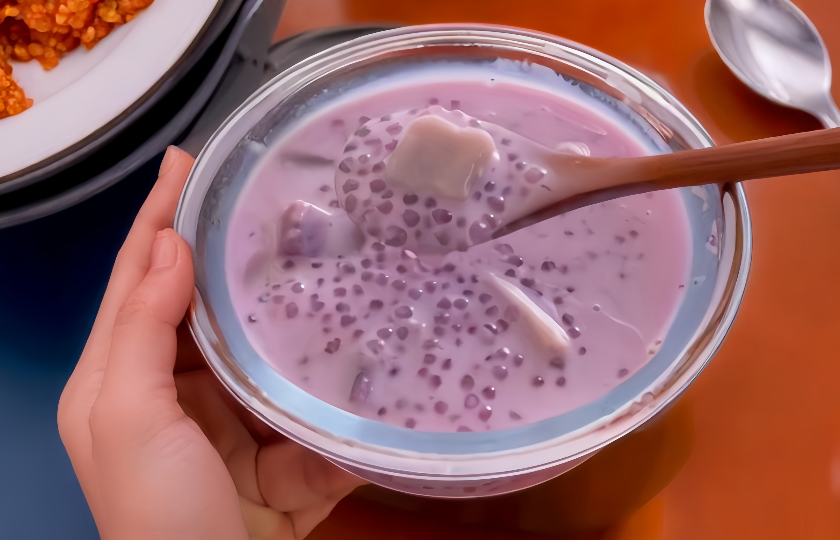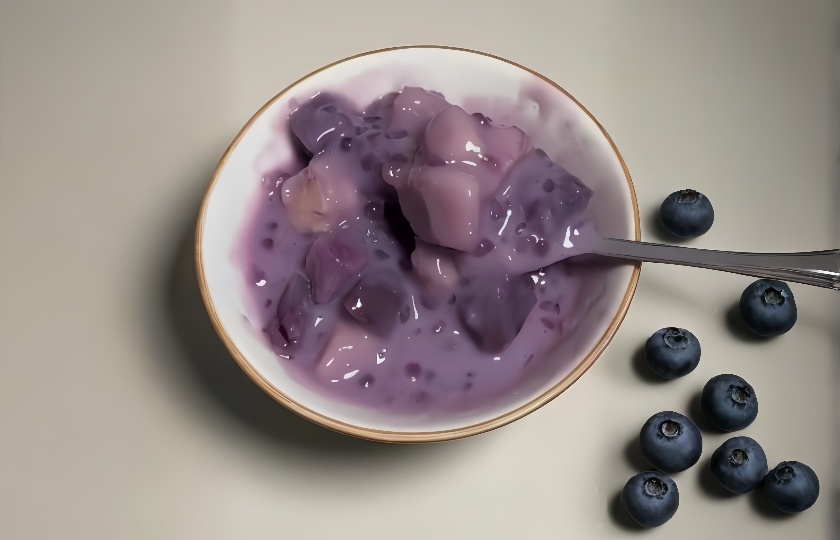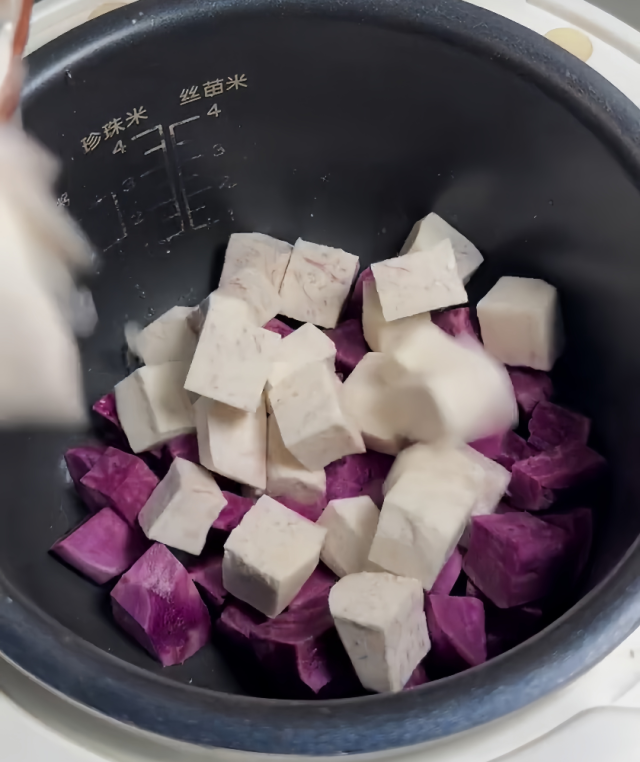Classic Purple Potatoes Recipe Easy

Purple potatoes can also be made in new ways! This classic and simple recipe adds unique creative elements, allowing you to create unique purple potato delicacies and amaze everyone's taste buds.
Why do I like this recipe?
This recipe is simple, convenient and delicious. You only need to put the materials into the rice cooker and press a button to complete it. You don't need to watch the heat, nor worry about overcooking or undercooking.
The combination of purple potatoes and taro is very clever, with rich taste levels. Purple potatoes are soft and dense, and taro is delicate. Coupled with the elasticity of sago, the overall taste is particularly smooth. The addition of rock sugar and milk not only increases sweetness but also makes the soup rich.
Moreover, it is especially suitable as breakfast or midnight snack. And you can cook a lot at one time. The leftovers can be heated in the refrigerator and eaten. It is very practical.

Required raw materials and substitutes
Main ingredients:
Purple potato: Provides sweetness and a unique color.
Taro: Increases aroma and a powdery texture.
Accessories:
Sago: Adds a granular texture and elastic mouthfeel.
Rock sugar: Adds sweetness and enhances the overall flavor.
Seasonings:
Milk: Provides a rich milky aroma.
Substitutes:
Purple potato: Can be replaced by sweet potato. The sweetness is similar, but the color is slightly lighter.
Taro: Can be replaced by pumpkin, adding a soft texture and a light fragrance.
Sago: Can be replaced by glutinous rice balls, bringing a similar mouthfeel.
Rock sugar: Can be replaced by white sugar. The sweetness is similar.
Milk: Can be replaced by coconut milk, providing a rich mouthfeel with a different flavor.
Can an electric rice cooker be replaced by a slow cooker?
Sure, and the effect will be even better. The slow cooker has a milder temperature and the ingredients are heated more evenly. Potatoes and taro will be cooked more softly, and sago will be more resilient.
For specific operations, it is recommended to cook on high heat for 1 hour first, then turn to low heat and continue cooking for 2 to 3 hours. You can add a little less water than when using an electric rice cooker because the slow cooker evaporates more slowly. Add milk in the last 15 minutes so that the taste will be more fragrant.
Another advantage of using a slow cooker is that you don't need to watch it. Once you put the ingredients in, you don't need to worry about it. It will automatically turn to keep warm when the time is up. The finished sweet soup will be more creamy than the version cooked in an electric rice cooker, and the fragrance of taro and purple potatoes will be more intense.
How to avoid taro from breaking easily?
Cut taro into larger pieces, about 2 centimeters square. In this way, it is not easy to break when cooking.
Soak taro in cold water for 15 minutes before cutting it. This can not only remove stickiness but also make taro stronger. When adding water, do not pour it directly on the ingredients but pour it slowly along the side of the pot.
INGREDIENTS
Main Ingredients
-
·200g purple potato
-
·200g taro
Additional Ingredients
-
·20g sago
-
·5 pieces rock sugar
Seasonings
-
·100ml milk
COOKING STEP
Step 1
Cut 200g purple potato and 200g taro into pieces and put them into the electric rice cooker.

Step 2
Pour in 20g sago and evenly scatter it on the purple potato and taro.

Step 3
Add 5 pieces of rock sugar and pour in boiled hot water. The amount of water should be enough to completely cover the ingredients.

Step 4
After stirring evenly, press the cooking button of the electric rice cooker and cook for about 30 minutes.

Step 5
When the time is up, open the electric rice cooker and pour in 100ml milk.

Step 6
Stir evenly again and it can be eaten.

More recipes worth trying
Easy Tomato-Braised Beef: A hearty one-pot comfort meal
Red Date Longan Sweet Soup With Egg
Classic Chinese Walnut Dessert Soup
Recipe variations
Adding nuts:
It's a good idea to add some chopped almonds, cashews, and walnuts after cooking. These nut pieces can add more chewiness to each bite and make it more enjoyable to eat. Moreover, they are rich in nutrition and instantly enhance the nutritional value of the entire delicacy, allowing you to have both deliciousness and health.
Coconut flavor version:
Replacing milk with coconut milk will immediately give a different flavor. Coconut milk has a rich coconut fragrance. After cooking, sprinkle some shredded coconut for decoration, as if you are on a tropical beach. The unique flavor instantly explodes, bringing a new experience to the taste buds.
Fruit flavor upgrade:
After cooking, throw in some diced mangoes, bananas, and apples. When the hot soup meets the natural sweetness of fruits, the taste is instantly enriched. The freshness of fruits and the soft and glutinous ingredients set off each other. Each bite is distinct in layers, sweet and refreshing.
Rich dessert style:
Finally, add some condensed milk or light cream, and the sweetness and richness of the whole dish will soar. Condensed milk and light cream are thick and sweet, turning it into a heartwarming dessert. Having a bowl on a cold day is full of happiness.
Bean combination:
Add pre-cooked red beans or mung beans and cook them together with purple potatoes and taro. Beans have a solid texture. When mixed with the soft and glutinous purple potatoes and taro, diverse textures collide on the tip of the tongue, and the feeling of fullness is also stronger. Having a bowl is extremely satisfying.
Eating suggestions
Combined with fruits: When eating, add some fresh fruits such as strawberries, blueberries, and diced mangoes. They are sweet, sour, and refreshing, and can also supplement vitamins, making the taste and nutrition even better.
Matched with beverages: Pair it with a cup of green tea or scented tea, or freshly ground coffee. The sweetness of desserts and the fragrance of beverages blend together and set off each other. The taste during the meal is indescribably wonderful.
Enjoy the chilled version: Let it cool down and refrigerate it in the refrigerator for 2 hours. Then pour some coconut milk or light cream. Immediately, it turns into a summer cooling tool. It is cool and refreshing. One bite will eliminate all the summer heat.
Matched with light meals: Eat it with whole wheat bread and low-sugar cakes. Staple foods bring a feeling of fullness and can also neutralize the sweetness of desserts. As an afternoon tea, it is comfortable and satisfying
FAQs:
If you scoop it up with a spoon and see that sago is transparent in the middle without a white core, it is cooked. If you find that sago is completely transparent but other ingredients are not soft enough, you can scoop out sago and put it back after the potatoes and taro are cooked.
After adding light cream, the sweet soup will become more creamy and smooth, and the taste is upgraded a lot. However, light cream is naturally sweet. It is best to reduce the rock sugar to 3 to 4 pieces. In addition, light cream should be warmed to room temperature in advance. Just stir gently when adding it.
The most important thing is to grasp the timing of addition. Add it when turning off the heat at the end just like milk. If you feel the taste is too thick, you can add a little warm water to adjust the consistency. It is better to drink it while it is hot as soon as possible after making it. Light cream will solidify if left for too long.
The purpose of stirring is to fully blend the milk and light cream with the sweet soup. Just gently stir a few times to ensure that there is no obvious layering. If left to stand, on the contrary, the light cream will slowly solidify and affect the taste.
It tastes best when drunk while it is hot. When the temperature is moderate, the milky fragrance and the sweet fragrance of purple sweet potato and taro can be fully reflected. If you make too much at one time and it cools down, it is recommended to quickly divide and store it while it is still warm. When you need to eat it, just heat it up a little.
In terms of taste, boiling with boiling water can quickly gelatinize the starch on the surface of potatoes and taro, lock in the moisture, and be soft and glutinous and delicious. Sago can also quickly take shape and be very chewy. When boiling with cold water, the ingredients soak in cold water for a long time, and some of the nutrition and taste are lost, so the taste is not as good.
In terms of nutrition, boiling with boiling water takes a short time, so there is less loss and damage to nutrition. Boiling with cold water takes a long time, so a large amount of nutrition is dissolved in the water, and an additional part is lost due to long-term heating.

















